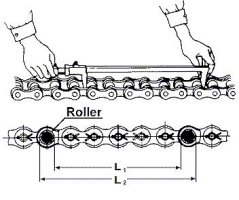Measureing your chain to see how far it has elongated past original pitch length is very important if you want to keep your chain and sprockets in optimum running order.
There are several methods given to measure a chain and see just what percentage of growth it is at, but I want to offer up this method for those of us who want to know precisely where our chains stand. Although a tape measure will do a much better job than the old "three finger on top of swingarm" , the "pull away from the back sprocket", or the "lay it on the floor andf flex it" methods, I want to offer the following method as the absoulte best way to corretly and accurately see where your chain is at:
Chain Elongation
Chain stretch is calculated as the total amount of elongation caused by wear on the pin and bushing, but not caused by deformation of the link plate. Remaining chain life can be estimated by measuring chain elongation.
This method can be used for any number of links, however the more links used the more accurate the calculation.
*(refer to the graphic provided)
1. The chain should be measured by stretching it slightly.
2. Measure the distance, using a vernier, of the inside (L1) and outside (L2) of rollers at both ends of the measured links, to get measurement (L).
L= L1+L2
2·
Chain elongation can then be calculated.
Chain Elongation= Measured Length - Std. Length x 100(%)
Standard Length
Standard Length = Chain Pitch x Number of Links
There are several methods given to measure a chain and see just what percentage of growth it is at, but I want to offer up this method for those of us who want to know precisely where our chains stand. Although a tape measure will do a much better job than the old "three finger on top of swingarm" , the "pull away from the back sprocket", or the "lay it on the floor andf flex it" methods, I want to offer the following method as the absoulte best way to corretly and accurately see where your chain is at:
Chain Elongation
Chain stretch is calculated as the total amount of elongation caused by wear on the pin and bushing, but not caused by deformation of the link plate. Remaining chain life can be estimated by measuring chain elongation.
This method can be used for any number of links, however the more links used the more accurate the calculation.
*(refer to the graphic provided)
1. The chain should be measured by stretching it slightly.
2. Measure the distance, using a vernier, of the inside (L1) and outside (L2) of rollers at both ends of the measured links, to get measurement (L).
L= L1+L2
2·
Chain elongation can then be calculated.
Chain Elongation= Measured Length - Std. Length x 100(%)
Standard Length
Standard Length = Chain Pitch x Number of Links
